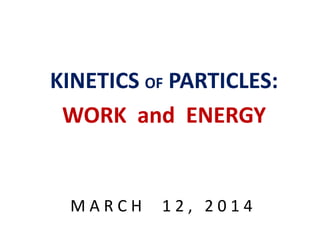
Work and Energy Principles
- 1. M A R C H 1 2 , 2 0 1 4 KINETICS OF PARTICLES: WORK and ENERGY
- 2. Integration of the Equations of motions to obtain the Principle of Work and Energy, principles that help to solve problems involving Force, Velocity and Displacement. KINETICS OF PARTICLES: WORK and ENERGY
- 3. Work of a Force - Force exhibits Work when it undergoes a displacement or it moves through some distance in the direction of the Force. Work done (U) U = Force X displacement U = F Cos d Vector Form U = F d
- 4. Work of a Force If the Force is variable then the Total Work done is U = F dS Units: F = Newton (N = kg.m/s2) U = Joule (J = N.m) Note: -Moment of a force and the principle of Work are in no way related. -Moment is a Vector Quantity and Work is a Scalar.
- 5. ENERGY Energy of a Body is its capacity of doing Work. It is equal to the work done in altering either its motion or its velocity. Kinetic Energy – energy possess by virtue of its motion Potential Energy – energy possess by virtue of its gravitational interaction
- 6. KINETIC ENERGY Kinetic Energy is measured in the amount of work which a body can perform against some resistance until it is brought to rest. F = -F to bring the body to rest there must be an opposing force F = - ma a = d/ds F = - m d/ds F ds = - m d integrate F ds = - m d Work done by a Force KE = - 0 m d KE = - m 2 d Kinetic Energy KE = ½ m2
- 7. PRINCIPLE OF WORK and ENERGY Equation of Particle: F = ma F Cos = mat Since dr = ds along the path, then at = d/ds, thus F Cos = m ( d/ds ) F Cos ds = m d integrate Assume limits: s = s1 and = 1 and s = s2 and = 2 F Cos ds = m d F Cos ds = ½ m 2 2 - ½ m 1 2 U1-2 = ½ m 2 2 - ½ m 1 2
- 8. PRINCIPLE OF WORK and ENERGY This equation represents the Principle of Work and Energy U1-2 = ½ m 2 2 - ½ m 1 2 Whereas, U1-2 - sum of the work done by all the forces on the particle as the particle moves from point 1 to point 2 ½ m 2 2 - ½ m 1 2- particle’s final and initial kinetic energy are positive scalar quantity since they do not depend on the direction of the velocity KE = T = ½ m 2 U1-2 = T2 - T1 T1 + U1-2 = T2
- 9. The 3500-lb car is travelling down the 10⁰ inclined road at a speed of 20 ft/s. If the driver wishes to stop his car, determine how far his tires skid on the road if he jams on the brakes causing his wheels to lock. The coefficient of kinetic friction between the wheels and the road is 0.5. EXAMPLE # 1
- 10. The Blocks A and B have a mass of 10 and 100 kg respectively. Determine the distance B travels from the point where it is released from rest to the point where its speed becomes 2 m/s. EXAMPLE # 2
- 11. The 20 lb crate has a velocity A = 12 ft/s when it is at A. Determine its velocity after it slides 6 ft down the plane. The coefficient of kinetic friction between the crate and the plane is 0.2 EXAMPLE # 3
- 12. A crate has a weight of 1500 lb. if it is pulled along the ground at constant speed for a distance of 25 ft, and the towing cable makes an angle of 15⁰ with the horizontal, determine the tension in the cable and the work done by the towing force. The coefficient of friction between the ground and the crate is 0.55 EXAMPLE # 4
